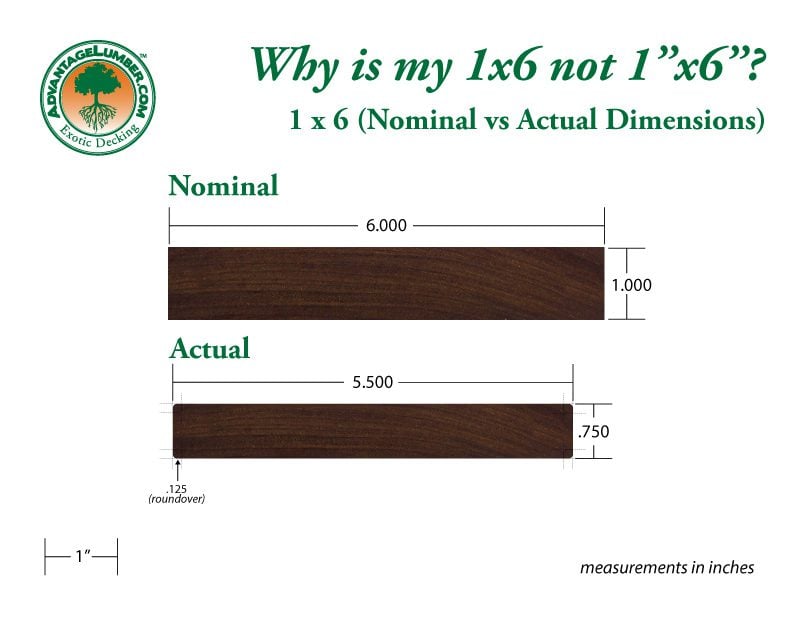
One of the greatest sources of confusion in the lumber industry is the difference between a board’s nominal dimensions and its actual dimensions.
Nominal Dimensions: The Standard Naming Convention
Nominal dimensions are the measurements you’re probably used to seeing. They are the names by which lumber is commonly known and sold, found in stores and on lumberyard labels. 1×6 and 2×4 are examples of nominal dimensions.
But here’s the catch: nominal dimensions aren’t the actual size of the board. A 2×4 board is not 2 inches by 4 inches; it’s actually slightly smaller, and therein lies the root of the confusion.
Actual Dimensions: The Real Size
In applications where precise measurements are crucial, you have to know the board’s actual dimensions (or finished dimensions). These are the real, physical size of the lumber, and, as noted above, they are always slightly smaller than the nominal dimensions. 0.75″ x 5.5″ and 1.5″ x 3.5″ are examples of actual dimensions.
Why the Difference?
Nominal dimensions are derived from the lumber’s size when it is first harvested and milled. This freshly cut board is too wet and rough for most applications. Before it can be used, it has to be dried and planed to a smooth finish. Wood shrinks as it dries, and planing literally removes material from the surface of the board. The result is a board that is slightly smaller by the time it is ready for sale than when it was first cut.
So why don’t we use the more accurate actual dimensions when buying and selling lumber? Tradition is part of it; the nominal dimensions are so ingrained in people’s minds that it would be nearly impossible to switch. But there are also a couple of practical reasons.
For one, actual dimensions are complicated and clunky. It’s a lot easier to ask for a 2×4 than to ask for a one-and-a-half-by-three-and-a-half.
Also, because wood is a natural product that adapts itself to its surroundings, there will always be some slight variation in sizing. Using rounded numbers allows for this natural variation without setting unrealistic expectations—as long as you understand what’s going on, of course.
Nominal to Actual Conversion Chart
To make things simple, here’s a chart converting all our most common nominal lumber sizes to their actual counterparts, in both imperial and metric:
| Nominal Size | Actual Size (Imperial) | Actual Size (Metric) |
|---|---|---|
| 1×4 | 0.75″ x 3.50″ | 19mm x 90mm |
| 1×5 | 0.75″ x 4.72″ | 19mm x 120mm |
| 1×6 | 0.75″ x 5.50″ | 19mm x 140mm |
| 1×4 +Plus® | 0.83″ x 3.50″ | 21mm x 90mm |
| 1×5 +Plus® | 0.83″ x 4.72″ | 21mm x 120mm |
| 1×6 +Plus® | 0.83″ x 5.50″ | 21mm x 140mm |
| 1×6 +Plus® XW™ | 0.83″ x 5.70″ | 21mm x 145mm |
| 5/4×4 | 1.00″ x 3.50″ | 25mm x 90mm |
| 5/4×5 | 1.00″ x 4.72″ | 25mm x 120mm |
| 5/4×6 | 1.00″ x 5.50″ | 25mm x 140mm |
| 5/4×8 | 1.00″ x 7.25″ | 25mm x 184mm |
| 5/4×10 | 1.00″ x 9.25″ | 25mm x 235mm |
| 5/4×12 | 1.00″ x 11.25″ | 25mm x 286mm |
| 2×2 | 1.50″ x 1.50″ | 38mm x 38mm |
| 2×4 | 1.50″ x 3.50″ | 38mm x 90mm |
| 2×6 | 1.50″ x 5.50″ | 38mm x 140mm |
| 2×8 | 1.50″ x 7.25″ | 38mm x 184mm |
| 2×10 | 1.50″ x 9.25″ | 38mm x 235mm |
| 2×12 | 1.50″ x 11.25″ | 38mm x 286mm |
| 3×4 | 2.50″ x 3.50″ | 64mm x 90mm |
| 3×6 | 2.50″ x 5.50″ | 64mm x 140mm |
| 3×8 | 2.50″ x 7.25″ | 64mm x 184mm |
| 3×10 | 2.50″ x 9.25″ | 64mm x 235mm |
| 3×12 | 2.50″ x 11.25″ | 64mm x 286mm |
| 4×4 | 3.50″ x 3.50″ | 90mm x 90mm |
| 6×6 | 5.50″ x 5.50″ | 140mm x 140mm |